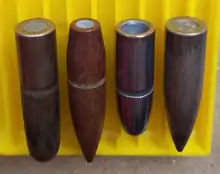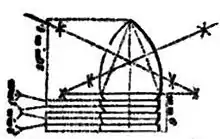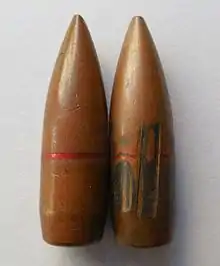Cannelure
A cannelure is a groove or channel around ammunition, either bullets[1] or cartridge cases.[2] The cannelure may be pressed into or cast with the bullet or case.

| Look up cannelure in Wiktionary, the free dictionary. |
Function
In the Minie Ball the purpose of the cannelure was two fold. For one it changed the center of gravity of the bullet so that it would turn in flight in the direction it was falling in, instead of maintaining an orientation pointing at the original line of sight from the barrel. The bullet would strike its target by the point, instead of being slightly misaligned.[3] The second purpose in the Minie ball and often in other bullets to be fired from black powder weapons was to hold a lubricant which would reduce the rate of bore fouling by black powder residue.[4] In modern bullets, such as the 7.62 illustrated here, the cannelure is pressed into the circumference of the bullet to provide a strong purchase for the mouth of the cartridge case when it is crimped onto the cannelure. This is done to prevent the bullet from moving either forward or backward in the case.[4][5]
While bullet setback can be a problem with any self-loading gun, it can also be a problem with bolt action rifles if the cartridges used are rimmed or semi-rimmed and are not positioned in a magazine so that the topmost cartridge can move freely into the chamber without catching on, and moving the cartridge below it. If this happens the lower cartridge may have its bullet damaged and also setback into the cartridge creating a dangerous problem.[6]
Revolvers that have heavy recoil (and even some that do not if used with poorly crimped cartridges) can have their bullet move forward out of the case. Once they move far enough, the cylinder movement will be stopped by the protruding bullet.[7]
Setback
In cartridges, the cannelure is a band pressed into the case which helps prevents cartridge setback when the case mouth is properly crimped onto the cannelure.[4] Bullet setback of .1" can increase pressure beyond safe limits and possibly cause a catastrophic failure.[8]
 The first 3 of these rifle bullets have cannelures
The first 3 of these rifle bullets have cannelures Minie Ball with 3 Cannelures
Minie Ball with 3 Cannelures 7.62×39mm bullets fired and unfired showing a red cannelure
7.62×39mm bullets fired and unfired showing a red cannelure Glaser Powerball with cannelured cases
Glaser Powerball with cannelured cases 9×19mm Parabellum with bullet setback by 1.2 mm
9×19mm Parabellum with bullet setback by 1.2 mm
References
- "cannelure". thefreedictionary.com. Retrieved 26 February 2017.
Firearms, Gunnery, Ordnance & Artillery) a groove or fluting, esp one around the cylindrical part of a bullet
- "Crimping". exteriorballistics.com. Retrieved 26 February 2017.
- "Barrel Twist and Bullet Stability". bisonballistics.com. Retrieved 26 February 2017.
When a statically imbalanced bullet travels down the bore, the off-center center of gravity will travel in a helical path
- "Handgun Cartridge Crimping". massreloading.com. Retrieved 26 February 2017.
photo of bullets with cannelures
- "Cannelure". hallowellco.com. Retrieved 26 February 2017.
- "Cartridges Rims: Rimmed vs. Semi-Rimmed vs. Rimless vs. Belted vs. Rebated - Part III". firearmshistory.blogspot.com. Retrieved 27 February 2017.
- "Sport Handgun Revolver Bullet". nosler.com. Retrieved 27 February 2017.
- Sweeney, Patrick (2001). The Gun Digest Book of the 1911. Gun Digest Books. p. 142. ISBN 978-0-87349-281-2.
The NRA found that setting the bullet back a short distance could double the chamber pressure when fired.